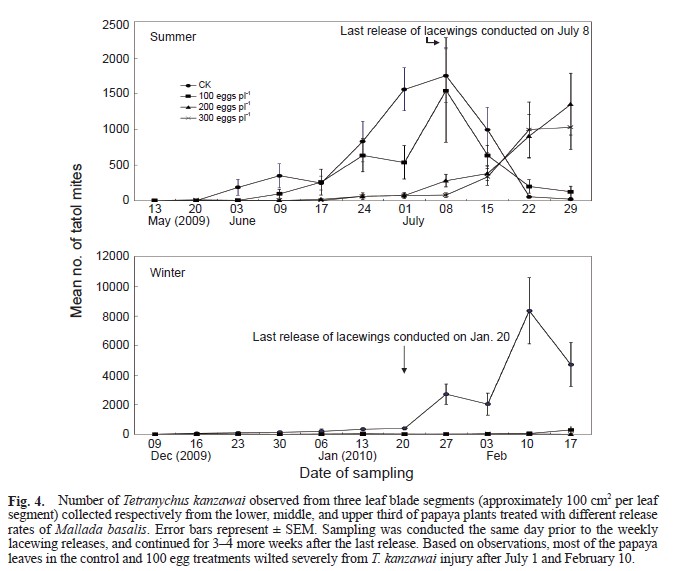All issues

Author:Chien-Chung Chen*, Ling-Lan Cheng, Yaw-Jen Dong, Chiu-Tung Lu, Wen-Jer Wu, and John S. Yaninek
Abstract:
Mallada basalis (Walker) is a generalist predator commonly found in agricultural fields in Taiwan, and is commercially available as a biological control product. A number of field investigations have indicated the potential of M. basalis as a biological control agent against several arthropod pest species; however, none have been carried out on pests of papayas. Likewise, there is no information on the fate of lacewing populations following their release in the field. This study investigated the feasibility of using M. basalis to control the primary acarine pest, Tetranychus kanzawai Kishida, on papaya in a screenhouse. The main objectives included determining optimal lacewing release rates, post-release population dynamics, and efficacy in controlling mites on papaya. Lacewings released at a rate of 200 eggs per plant during the summer reduced T. kanzawai populations by 95% on average. Mite populations were lower during the winter and required half the summer lacewing release rate to achieve the same level of control. The impact of M. basalis on T. kanzawai was similar on various life stages of the mite, both sides of the papaya leaves, and throughout the canopy regardless of leaf strata. Lacewing egg hatch success following release in a screenhouse exceeded 70%. However, subsequent larval densities rapidly declined to less than 5 per papaya plant during our weekly censuses. Lacewing populations did not accumulate through successive releases suggesting that conditions in the papaya screenhouse were not favorable for M. basalis development or establishment. Although sustained population of M. basalis could not be established in the papaya screenhouse, inundative releases of M. basalis at a rate of 100 to 200 eggs per plant depending on the season could be applicable as a biological means to control T. kanzawai on papaya in screenhouses.
Key words:Tetranychus kanzawai, Mallada basalis, Biological control, Inundative release, Papaya
Download:![]() PDF Links
PDF Links
- 1. Development of Tractor-Mounted Seedling Transplanter for Sweet Potato
- 2. Synergistic Effect of Additional Gas on the Toxicity of Phosphine to Sitophilus oryzae and Sitophilus zeamais (Coleoptera: Dryophthoridae)
- 3. Effects of Temperature and Solar Radiation on Growth Traits and Plant Elements in Purple Leafy Sweet Potato
 Submit your manuscript
Submit your manuscript
 Guide for authors
Guide for authors